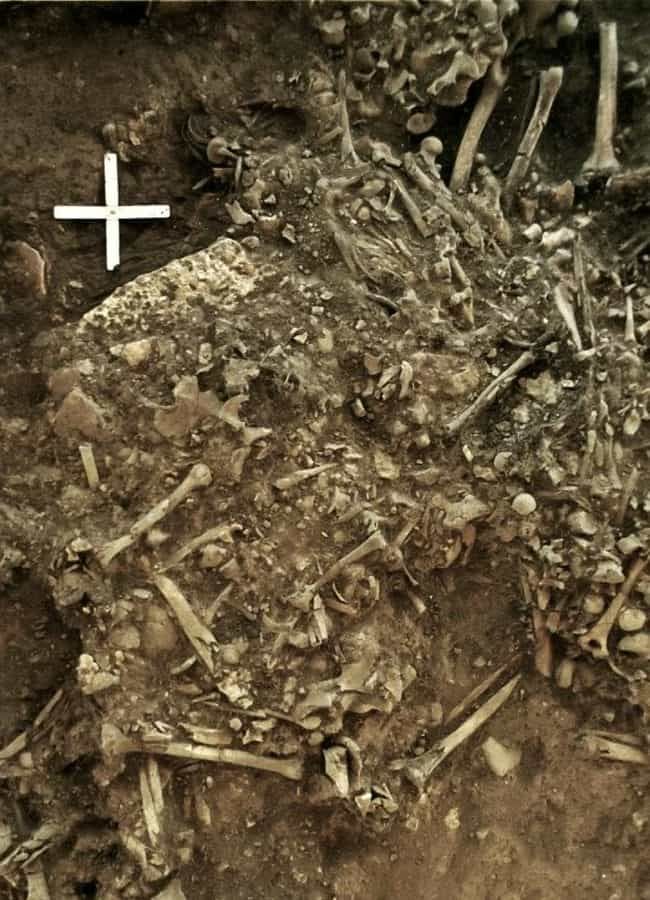Europe’s first farmers could have been wiped out by the earliest known Black Death nearly 5,000 years ago, a new study claims.
The oldest strain of plague that’s ever been discovered was found in a 20-year-old Stone Age woman who died 4,900 years ago in southern Sweden.
The finding could rewrite the history on the decline of Neolithic Europeans and their replacement by invaders from the steppes in the east.
At the time these farmers lived in large settlements that were dirty and traded surplus goods – and this trade could have let the plague spread at the dawn of the Bronze Age.
It had been thought the invaders from the east brought plague with them but the new findings suggested there was a breakout of the virulent strain before they arrived.
The French, Swedish and Danish researchers identified the new strain of Yersinia pestis, the bacteria that causes plague, and it is the closest ever identified to the genetic origin of plague.
Senior author Associate Professor Simon Rasmussen at the Technical University of Denmark and the University of Copenhagen explained: “Plague is maybe one of the deadliest bacteria that has ever existed for humans.
“And if you think of the word ‘plague,’ it can mean this infection by Y. pestis, but because of the trauma plague has caused in our history, it’s also come to refer more generally to any epidemic.
“The kind of analyses we do here let us go back through time and look at how this pathogen that’s had such a huge effect on us evolved.”
The evolution of the plague was mapped through genetic data from ancient humans, screening for sequences similar to more modern plague strains..
The strain in the Swedish woman had the same genes that make the pneumonic plague deadly today.
Traces of it were also found in another individual at the same grave site suggesting that the young woman did likely die of the disease.
By comparing it to other strains, the researchers were able to determine that it’s also the most basal, meaning that it’s the closest strain we have to the genetic origin of Y. pestis.
It likely diverged from other strains around 5,700 years ago, while the plague that was common in the Bronze Age and the plague that is the ancestor of the strains in existence today diverged 5,300 and 5,100 years ago, respectively.
This suggests that there were multiple strains of plague in existence at the end of the Neolithic period.
Prof Rasmussen added the finding offers a new theory about how plague spreads.
Massive human migrations from the Eurasian steppe down into Europe are known to have occurred around 5,000 years ago.
But how these cultures were able to displace the Neolithic farming culture present in Europe at the time is still debated.
Previous researchers suggested the invaders brought the plague with them, wiping out the large settlements of Stone Age farmers when they arrived.
But if the strain of plague the researchers found in the Swedish woman diverged from the rest of Y. pestis 5,700 years ago, that means it likely evolved before these migrations began and around the time that the Neolithic European settlements were already starting to collapse.
At the time, mega-settlements of 10,000 to 20,000 inhabitants were becoming common in Europe, which made job specialisation, new technology, and trade possible.
But they also may have been the breeding ground for plague.
Prof Rasmussen explained: “These mega-settlements were the largest settlements in Europe at that time, ten times bigger than anything else.
“They had people, animals, and stored food close together, and, likely, very poor sanitation.
“That’s the textbook example of what you need to evolve new pathogens.
“We think our data fit.

“If plague evolved in the mega-settlements, then when people started dying from it, the settlements would have been abandoned and destroyed.
“This is exactly what was observed in these settlements after 5,500 years ago.
“Plague would also have started migrating along all the trade routes made possible by wheeled transport, which had rapidly expanded throughout Europe in this period.”
The plague then spread out from big settlements to smaller communities where the woman was found.
She is also not genetically related to the people who invaded Europe from the Eurasian steppe, supporting the idea this strain of plague arrived before the mass migrations did.
The archaeology also supports this hypothesis, as there were still no signs of the invaders by the time she died.
But the researchers have not yet identified the plague in individuals from the mega-settlements where it may have evolved.
Prof Rasmussen said: “We haven’t really found the smoking gun, but it’s partly because we haven’t looked yet.
“And we’d really like to do that, because if we could find plague in those settlements, that would be strong support for this theory.
“We often think that these superpathogens have always been around, but that’s not the case.
“Plague evolved from an organism that was relatively harmless. More recently, the same thing happened with smallpox, malaria, Ebola, and Zika.
“This process is very dynamic – and it keeps happening.
“I think it’s really interesting to try to understand how we go from something harmless to something extremely virulent.”
The study was published in the journal Cell.
By Tony Whitfield
